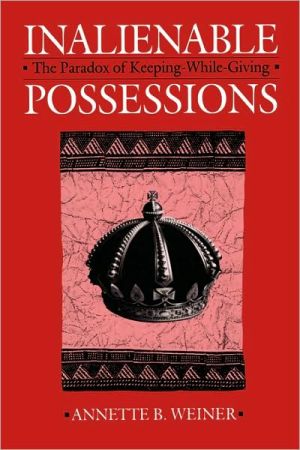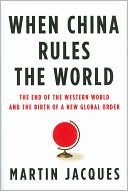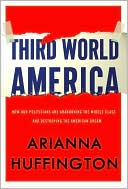Inalienable Possessions: The Paradox of Keeping-While Giving
Inalienable Possessions tests anthropology's traditional assumptions about kinship, economics, power, and gender in an exciting challenge to accepted theories of reciprocity and marriage exchange. Focusing on Oceania societies from Polynesia to Papua New Guinea and including Australian Aborigine groups, Annette Weiner investigates the category of possessions that must not be given or, if they are circulated, must return finally to the giver. Reciprocity, she says, is only the superficial...
Search in google:
"Weiner provides not only a new perspective on social and natural reproduction but also a framework through which to compare societies. This is an original point of view that will have real effects on the direction of future fieldwork and comparative analysis."—Ivan Karp, Smithsonian Institution
Inalienable Possessions\ The Paradox of Keeping-While-Giving \ \ By Annette B. Weiner \ University of California Press\ Copyright © 1992 Annette B. Weiner\ All right reserved.\ ISBN: 9780520076044 \ \ \ \ \ Introduction \ In the little houses the tenant people sifted their belongings and the belongings of their fathers and of their grandfathers. Picked over their possessions for the journey to the west…. The men were ruthless because the past had been spoiled, but the women knew how the past would cry to them in the coming days….\ When everything that could be sold was sold…still there were piles of possessions;….\ The women sat among the doomed things, turning them over and looking past them and back. This book. My father had it. He liked a book…. Got his name in it. And his pipe—still smells rank…. Think we could get this china dog in? Aunt Sadie brought it from the St. Louis Fair. See? Wrote right on it…. Here's a letter my brother wrote the day before he died…. No, there isn't room.\ How can we live without our lives? How will we know it's us without our past?\ John Steinbeck, The Grapes of Wrath\ This book has its origins in my first ethnographic field-work in the Trobriand Islands located off the coast of Papua New Guinea that, early in this century, took onunprecedented anthropological importance through Bronislaw Malinowski's research and personal renown. Malinowski reduced the extensive exchange events hewitnessed to a simplified but pioneering classification of “gift” and “counter-gift,” theorizing that reciprocity was the basis for social relations in “primitive” societies. My research, beginning sixty years later, revealed dynamic social actions far more socially dense than Malinowski's classic conclusions. While comparing what I found in the Trobriands with analogous situations in more politically hierarchical Polynesian societies, I realized how deeply his assumptions were grounded in nineteenth-century evolutionary beliefs about the communal nature of “primitive” economics.\ The “norm of reciprocity” is, in actuality, a theory of economic behavior whose anthropological tenets were shaped centuries earlier. During the rise of capitalism, the give and take of reciprocity took on an almost magical, sacred power among Western economists. In the eighteenth century, Adam Smith and others argued that reciprocal relations operated in the marketplace sui generis, keeping the market equitable and stable without external legal controls. A century later, this same belief in reciprocity as a regulatory mechanism was described for “primitive” societies when it was thought that “natives” lived without governing bodies or legal codes. There the gift given and received kept groups socially and politically stable without recourse to government or law. This trust in the motivation behind “primitive” reciprocity persisted so that confidence in how the norm worked in the exchanges of thousands of seemingly inconsequential gifts enabled anthropologists, beginning with Malinowski, to determine fixed, rational criteria for the reciprocal acts they recorded ethnographically. But these criteria, thought to be more scientifically and theoretically sound, also were culture bound so that, over time, it remained even more difficult to perceive how Western economic rationalities were being imposed on theories of other cultures' economic systems.\ The acceptance of gender ideologies fundamental to capitalist systems introduced other formidable problems for anthropological theory. Analytical dichotomies, such as stasis/change, nature/culture, and domestic/public, always identified women with the supposedly negative side. Theories grounded in ethnographic descriptions of “gift exchange” among men served to affirm and legitimate men's autonomous control in economic and political pursuits. Women, though physically present, were seen but ignored as active participants in their own right. Even their own productive efforts that supported or enhanced a society's economy were discounted.\ In many societies throughout the world, however, women are theproducers and, in part or wholly, the controllers of highly valued possessions—a currency of sorts made from “cloth.”1 Intricate symbolic meanings semantically encode sexuality, biological reproduction, and nurturance so that such possessions, as they are exchanged between people, act as the material agents in the reproduction of social relations. Most important, cloth possessions may also act as transcendent treasures, historical documents that authenticate and confirm for the living the legacies and powers associated with a group's or an individual's connections to ancestors and gods. Historically, women's control over these arenas has accorded them powers associated with magical potency, sacred prerogatives, political legitimacy, and life-giving and lifetaking social controls.2 Although Simone de Beauvoir asserted that gender is a “historical situation” and that biological reproduction is surrounded by historically constructed (negative) conventions and meanings, neither she nor other feminists attend to the political significance of women's complex roles in these cosmological domains. Other objects, however, such as shell, stone, precious metals, or even human bones that are usually associated with men's wealth, contain similar symbolic referents to biological and cosmological phenomena. And in these cases, the ethnographic literature abounds with classifications in which men's actions are privileged because they are connected to the sacred domain whereas women's similar activities are relegated to a profane category.\ These interpretive discrepancies illuminate the pervasiveness of Western thought where women's participation in biological reproduction and nurturance are fetishized with negative value. But when the commingling rather than the oppositions between female and male symbol systems is seriously considered, we find that women's control over political and cosmological situations and actions can be beneficent or malevolent, matching the ambiguous potential of men's control and power. This view also reveals the sociopolitical ramifications of how women and men are, at the same time, accorded and deprived of authority and power. Men's autonomy is held in check, undermined, supported, confounded, or even, at times, superseded by women's economic presence.\ The subject of this book is not women per se but an attempt to cast off some of the most cherished precepts in social theory and, in so doing, establish a new practice for comparative ethnographic description and explanation. Ethnographic data cannot be easily pared down to a single semantic marker that encodes reciprocity. Possessions aregiven, yet not given. Some are kept within the same family for generations with retention not movement, bestowing value. Ironic ambiguities exist in the games people play, in the perverse strategies they employ, and in the complex symbols they use. In practice, kinship is a decisive marker and maker of value, not in terms of genealogical rules or norms of behavior, but because certain basic productive resources express and legitimate social relations and their cosmological antecedents in spite of all the exigencies that create loss. The reproduction of social relations is never automatic, but demands work, resources, energy, and the kind of attention that continually drains resources from more purely political endeavors. Just as a nation's international economic policies are held in check by the powerful demands and strategies of, for example, the country's auto makers, agrofarmers, and oil producers, so too, in local situations, the demands of wives on husbands, sisters on brothers, and one generation on another, tilt production and exchange in directions that limit wider coalitions.\ When we acknowledge that so-called secondary domestic values such as biological reproduction and nurturance as well as the “magical” values of cosmologies and gods underwrite economic and political actions, then the traditional public/domestic boundaries break down. Social theory must account for exchange events that acknowledge women's possessions and social actions as much as men's. The division of labor is not simply a dual gender construct, but encompasses the attention and effort that both women and men give to production and to those cosmologies that disguise the unresolvable tensions, problems, and paradoxes that make up social life.\ Cosmologies are the cultural resources that societies draw on to reproduce themselves. But these resources are not merely ideologies, located outside the production of material resources. The traditional dichotomy between cosmology or superstructure and the material resources of production and consumption leaves little space to explore the cultural constructions by which the reproduction of the authority vested in ancestors, gods, myths, and magical properties plays a fundamental role in how production, exchange, and kinship are organized. To emphasize and overcome this problem, I use the term cosmological authentication to amplify how material resources and social practices link individuals and groups with an authority that transcends present social and political action. Because this authority is lodged in past actions or representations and in sacred or religious domains, to those who draw on it it is a powerful legitimating force. As Thomas O.\ \ \ \ Beidelman pointed out a long time ago, “one must understand the cosmology of the people involved so that one has some idea of what they themselves believe that they are doing.”3 Ethnographically, the people involved attest to the primacy and power of cosmological phenomena. For the Swazi, an intrinsic reproductive essence lies at the center of the Incwala royal rituals; Australian Aborigines claim that the a priori essentialness of their social life is constituted in The Dreaming; Polynesians consider that the efficacy of procreative power can only be found in the magical potency of mana.\ Of course, only to follow Polynesians' explanations is to elevate cosmology to a level of first principles, returning us to the Durkheimian position that all social life comes into being through the sacred, cosmological domain. For Emil Durkheim, the maintenance of the sacred—totemism as the case in point—was unambiguous, generating social solidarity that resulted in a homogeneous order. Like the norm of reciprocity, Durkheim believed that the sacred domain functioned as a totality never needing external control. A traditional Marxist position equally circumscribes cosmological phenomena as unproblematic because the sacred domain supports ideologies that function only to mystify and disguise domination and subversion. How then can we account for the symbolic and material complexities prefigured by distinctions and discriminations associated with gender when historically women have held claims to authority through their power over cosmological authentication? First, we must acknowledge that cosmologies act directly on social life mediating and, at the same time, fomenting society's most unresolvable problems. Second, we must see how power is constituted through rights and accesses to these cosmological authentications that give value to certain kinds of possessions which are fundamental to the organization of exchange. And third, because through exchange the cosmological domain becomes a significant source of power, its ambiguity and precariousness create difference, not homogeneity.\ Unfortunately, much of the history of anthropological theory has been a search for universals, a positivist approach that would discover rules of descent, the incest taboo, totemism, or reciprocity and then elevate these norms to a privileged position. Yet it is the paradoxes of social life that contain the seeds of first principles—those duplicities and ambiguities that create tensions that can only be ameliorated and never resolved. Exchange acts fuel these tensions because all exchange is predicated on a universal paradox—how to keep-while-giving. In the closingparagraph of The Elementary Structures of Kinship, Claude Lévi-Strauss describes a universal dream expressed in an Andaman Island myth which tells of “a world in which one might keep to oneself” and escape from the “law of exchange.”4 Turning his back on Durkheim's primacy of myth and ritual to project his own scientifically determined structural model, Lévi-Strauss dismisses this myth as fantasy—and so undercuts the very precept by which exchange value is determined.\ The Paradox of Keeping-While-Giving \ Some things, like most commodities, are easy to give. But there are other possessions that are imbued with the intrinsic and ineffable identities of their owners which are not easy to give away. Ideally, these inalienable possessions are kept by their owners from one generation to the next within the closed context of family, descent group, or dynasty. The loss of such an inalienable possession diminishes the self and by extension, the group to which the person belongs. Yet it is not always this way. Theft, physical decay, the failure of memory, and political maneuvers are among the irrevocable forces that work to separate an inalienable possession from its owner. We all are familiar with the crowns of queens and kings—the signs and symbols of authority and power—or antique furniture and paintings that proclaim a family's distinguished ancestry. From environmental concerns for the future of the world's rain forests to the political controversies generated over the return of the Parthenon's Elgin marbles to Greece, certain things assume a subjective value that place them above exchange value. When a Maori chief brandishes a sacred cloak she is showing that she is more than herself—that she is her ancestors. This is the power of cosmological authentication. The chief incorporates her ancestors' fame, their rank, and their authority unto herself; her guardianship of the cloak accords her that right. In a similar way, a noted Japanese Noh performer told me that when he dons the Noh mask of Okina, he becomes not like the god, but is the god.\ Gregory Bateson long ago saw the problems inherent in a functional or structural theory of reciprocity. His formulation of schismogenesis based on his Iatmul fieldwork was an attempt to find the “governor” that prevented the constant giving and receiving in an exchange or ritual event from spinning out of control.5 In fact, inalienable possessions that groups and individuals hold dear to them act as that governor. Inalienable possessions do not just control the dimensions of giving, but their historicities retain for the future, memories, either fabricated or not, of the past. Not always attainable, keeping some things transcendent and out of circulation in the face of all the pressures to give them to others is a burden, a responsibility, and at best, a skillful achievement.\ Even though permanence for all time is an impossibility, individuals and groups work with exacting care to recreate the past for the present so that what they do in the present affects the future. As the Spanish philosopher, Miguel de Unamuno y Jugo, observed, “reason builds on such irrationalities.”6 Unamuno believed that human beings “live in memory and by memory” and that the basis of social life was “the effort of our memory to persist…to transform itself into our future” even in the face of our foreboding of death.7 Sigmund Freud, of course, had a much more pessimistic view of how the unconscious urge toward death directs human actions. More recently, contra Freud, Ernest Becker argues that the very fear of death haunts us from birth, motivating us toward acts of heroism that give us “a feeling of primary value, of cosmic specialness, of ultimate usefulness to creation, of unshakable meaning.”8 Examples of heroic ventures through which individuals strive for immortality in efforts to deny death fill the pages of people's histories. These acts of “heroism” manifest themselves in behaviors as diverse as the enactment of a first birth ritual, the building of a pyramid, the recitation of a genealogy, the naming of a college dormitory, or the carving of a totem pole.\ The motivation for keeping-while-giving is grounded in such heroic dynamics—the need to secure permanence in a serial world that is always subject to loss and decay. Enormous energy and intensity are expended in efforts to transmute or transcend the effects of deterioration and degeneration and/or to foster the conditions of growth and regeneration. Therefore, attention to regenerating or recreating the past is neither random nor inconsequential. Historical consciousness is promoted; change is disguised. Situations of political revolution or rebellion, where hierarchy is so developed that one segment of the society revolts, appear to be exceptions. Yet when the victors claim leadership, they immediately constitute their legitimation through the creation of symbols that stand for the past. Consider how the leaders of the T'ang dynasty used regalia from earlier times to fabricate their genealogical connections to former rulers.9 In much the same way, Joseph Stalinused V. I. Lenin's body to create an inalienable monument that helped legitimate his legal right to rule,10 whereas following the revolution, all heirs to the Tzar were shot, their buried bodies exhumed, their bones burned, crushed, and scattered to prevent any relic from ever reemerging as the rallying point for a counterrevolution.\ Even small groups expend enormous efforts and resources, for example, to convince a younger generation to beware of loss, to preserve relationships, and to guard sacred possessions. In Ian Dunlop's fascinating films on Baruya male initiation, young men, dressed in thick layers of women's fibrous skirts which scratch their legs, are told by the older men that the skirts scratch them as a reminder never to forget the women; their task as adults is always to protect them.11 Later, in what is the most self-reflexive part of the film, the Baruya men uncover an ancient stone axe blade. Turning to the anthropologist, Maurice Godelier, the Baruya leader says that they have kept this most precious possession secret from him all the years that he has lived with them. Now they reveal it and in so doing, disclose their true social identities. Unlike other possessions, the axe blade embodies their ancestors' histories. Such moments capture the determination to defeat change by substituting an icon of permanence even if manifested in a Baruyan axe blade, an Australian sacred ancestral tjurunga stone, or a Maori ruler's woven cloak.\ The paradox inherent in the processes of keeping-while-giving creates an illusion of conservatism, of refashioning the same things, of status quo. Although possessions, through their iconographies and histories, are the material expressions of “keeping,” the most that such possessions accomplish is to bring a vision of permanence into a social world that is always in the process of change. The effort to make memory persist, as irrational as the combat against loss can be, is fundamental to change. The problems inherent in “keeping” nurture the seeds of change.\ The Paradox of Permanence and Loss\ Anthropologists have labored long over the question of change in human societies. Lévi-Strauss, for example, subverted the issue by defining entropy as the hidden “purpose” of culture crystallized in his image of the “primitive” bricoleur continually refabricating different versions of the same thing—what Robert Murphy terms “ZenMarxism.” Marshall Sahlins, recognizing that change must be accommodated in any dynamic structuralist theory, shows change as the central feature of how the cultural order reproduces itself. But in his examples of Polynesians' reactions to Western contact, Sahlins is not completely disengaged from his earlier evolutionary framework. Following Lévi-Strauss's metaphorical distinction between “hot” and “cool” societies, Sahlins maintains that differences in social complexity can be equated with a society's responsiveness to stasis or change. Implicit for Sahlins (and much more explicit for Lévi-Strauss) is that some groups, such as Australian Aborigines, are closed to change, merely replicating the same things through time. In “ranking” societies where history is more formalized and rank accommodated through lengthy genealogies, Sahlins shows much more dynamically that “the cultural order reproduces itself in and as change.”12\ In the first volume of Capital: A Critique of Political Economy, Marx emphasizes how continuity in the conditions of production cannot be achieved without the necessary conditions for reproduction, thereby underscoring how change stands as a constant threat to reproducing surplus value. For example, in the long-term maintenance of relations between capitalists and wage-laborers, both parties must deal with dislocating circumstances, such as external immigration policies and markets for raw materials and internal conditions of the housing and training of workers. Even wars, famine, and public opinion were among the events that Marx enumerated.13 To minimize change, to respond to shifting situations rapidly, to prevent workers from controlling their own destinies are some of the social conditions that must be attended to so that change can be incorporated into the reproduction of the relations of production.\ The opposition between change and stasis when applied to a division between “egalitarian” and “ranking” societies obscures the more fundamental problem that Marx identified. In reproducing kinship relations and political alliances in small-scale societies, change also is a condition that must be worked against. How these societies reproduce the past for the future in and through loss is the key question. In one sense, an inalienable possession acts as a stabilizing force against change because its presence authenticates cosmological origins, kinship, and political histories. Yet the possession may be the very symbol of change as those in the top ranks of a society may combat change by reconstructing or fabricating genealogies or sacred chronicles in order to identify themselves with the possessions of earlier leaders or dynasties. In other circumstances, those further down may well fight for change, invoking connections to other, more obscure symbols.14 In Gandhi's struggle for India's national independence, he invoked the hand spinning of a traditional cloth called khadi, what Nehru later called Gandhi's “livery of freedom.”15 Both the act of spinning and the wearing of khadi elicited a complex symbolism, reasserting women's traditional productive domain and uniting women and men against the economic tyranny of Manchester's manufactured cottons and the political hegemony of British rule. When we take such possessions as a serious subject of study, teasing apart their histories and how their subjective value is constituted, we find that such possessions, as they move in time and space, become the carriers of more information and greater authority than other kinds of things. Control over their meanings and transmission from one generation to the next accords authority to their owners.\ The power generated by this authority reveals a further ambiguity in the nature of inalienable possessions. Because each inalienable possession is subjectively unique, its ownership confirms difference rather than equivalence. Exchange does not produce a homogeneous totality, but rather is an arena where heterogeneity is determined. Although individuals or groups negotiate with each other on many levels in each exchange encounter, the ownership of an inalienable possession establishes and signifies marked differences between the parties to the exchange. The possession not only authenticates the authority of its owner, but affects all other transactions even if it is not being exchanged. For the possession exists in another person's mind as a possible future claim and potential source of power. If I possess a sacred cloth, in Walter Benjamin's terms, its “aura” extends to my other possessions as well because my social identity, rank, or status is legitimated by my possession of one sacred object.16 Such ownership gives me authority that operates in other transactions so that my ability “to keep” empowers my ability to attract. In other words, things exchanged are about things kept.\ The paradoxical tension created by keeping-while-giving exists at the root of all attempts to defeat loss. To overcome the destructiveness of loss, individuals and groups devise myriad ways of disguising the impermanence of social life. But these are not benign efforts to counterbalance death. They are grounded in exchange arenas where difference in the present is affirmed whereas difference in the past is disguised. These are the dynamics in which inalienable possessions are empoweredto act as the source of difference and hierarchy. The strategies and negotiations surrounding inalienable possessions acknowledge the complementarity, the domination, and the subversive tactics that, taken together, show the extent or limitations in transforming difference into rank and hierarchy.\ In this way, inalienable possessions are the representation of how social identities are reconstituted through time. The reproduction of kinship is legitimated in each generation through the transmission of inalienable possessions, be they land rights, material objects, or mythic knowledge. These possessions then are the most potent force in the effort to subvert change, while at the same time they stand as the corpus of change. Among Australian Aboriginal groups, The Dreaming provides the means through which parts of ceremonies, sacred names, songs, and body designs are given to others, creating a strong sense of relatedness among dispersed, widely distant groups of people.17 But some individuals attain more sacred knowledge than others, so that even with a strong egalitarian ethos, difference enters into each encounter. Whatever exchanges occur between elders and younger kin are influenced by the fact that elders hold the inalienable possessions—sacred stones, ceremonies, totemic designs, and names—giving them authority because others desire what they have. In this way, the Aboriginal cosmology is a fertile source of inalienable possessions that are guarded, inherited, sometimes lost, and at times, conceived anew. In general, cosmologies are active forces in social life that, in mediating systems of meaning, also entail material or verbal objectifications that actively become the agents or instruments of change.\ Thus the bricoleur mystifies change in order to create and participate in change. Birth, decay, and death are the natural phenomena and the wellspring out of which difference emerges. Inalienable possessions are powerful because they represent and encompass these primary sources making difference a potential threat and a tangible reality. But even though inalienable possessions are dominant politically, they are not simply under the control of men. Women, too, are centrally involved in their production and guardianship as well as their cosmological authentication. Maori cloaks, woven by women, symbolize women's rights to ancestral prerogatives and the legitimization of rank for women and men. Australian Aboriginal hairstrings, an important component of ceremonial life, are often produced and exchanged by women. The list of such involvement by women in production and exchange is lengthy, yet ignored in exchange theories. At the core of the paradoxical tensions over keeping-while-giving is the problem of gender.\ \ \ \ The Paradox of Reproduction and Gender.\ Great strides have been made over the past twenty years in the anthropology of gender, but it still remains difficult to overcome functionalist or structuralist theories that claim to govern social practice from above while associating gender with categorical definitions or single symbolic systems grounded in ranked oppositional patterns. What generates such a long historical attachment to these theoretical positions is that, to date, studies of gender have been uncritical in their acceptance of the primacy of a norm of reciprocity. Exchange theories reveal strongly entrenched gender biases because the relevant subject matter remains what males exchange between one another. For me, my first question in the Trobriands was, would Malinowski have ignored Trobriand women's banana-leaf wealth if men had produced and exchanged it? Subsequently, I saw the same bias repeated in other societies, most notably in relation to the multiplicity of symbols, possessions, and exchange events associated with sexuality and reproduction.\ In the 1960s, John Murra argued that Peruvian fabrics provided the economic basis as tribute and treasure for the rise of Inka civilization. But even with this example of cloth produced by women, the production and accumulation of such wealth has never been considered an essential resource in theories of political evolution.18 In cases where fabrics are manufactured wholly or largely by men, cloth still is considered by anthropologists as a subsidiary resource, a soft object whose symbolic meanings relate to cosmology, ancestors, birth and death, and the woman's side of things. Against the hard currencies of gold, silver, or shells that anthropologists usually define as encapsulating individual heroic exploits, clan political prestige, or the groom's side in marriage, cloth wealth, like the economic presence of women, fades in analytical importance. But the recent volume of essays. Cloth and Human Experience, shows how politically vital cloth can be in cultures ranging from chieftaincies to large-scale class societies, as such possessions provide repositories of wealth to be kept as well as to be given away.19 Although on a global scale and over several centuries women played a larger role than men in cloth production, any universalizing between gender and hard and soft wealth excludes how much men are involved with anddependent upon cloth treasures. Similarly, women's symbolic and social involvement in the circulation and guardianship of hard substances, such as jade, shells, or even ancestral bones, at times intersects with men's political actions.\ The analysis of cloth reveals more than the complex interweaving of gender and production. For inalienable possessions, both soft and hard, evoke widespread, common symbolism associated with human reproduction and the cultural reproduction of the kin group, be it family, clan, or dynasty, accomplished primarily through keeping-while-giving. Cultural reproduction also includes the cosmological authentication of inalienable possessions through which the presence of ancestors or gods legitimates divinity, chieftaincy, or eldership. These processes reveal how sexuality and reproduction are intimately part of social practice, played out in a range of social actions surrounding the rituals of death, marriage, birth, inheritance and the transmission of ancestral authority. Over a decade ago, Pierre Bourdieu argued, contra Lévi-Strauss, that marriage patterns did not follow formal, structural rules, but rather grew out of complex strategies, part of an “entire system of biological, cultural, and social reproduction.”20 Yet rarely are the cultural rituals and meanings associated with human reproduction or cosmological authentication brought into economic consideration. Although Friedrich Engels noted that biological reproduction provided the basis for the social relations of production, he never pursued this point to show how the political relations of biological reproduction have changed over time, shaping Western social and political histories.21 In fact, even among many feminists, the irreversible fact that women give birth has long been viewed as the proof of biology as destiny, that women's bodies de facto relegate them to homes, childcare, and domination by men. Although in Western traditions, men have organized ways to relegate biological reproduction and women to a private domain while they controlled the public institutions that legitimated primogeniture, kinship, and kingship the negative value accorded biological reproduction is by no means universal.22\ Anthropologists, however, in their analyses of non-Western traditions, followed similar Western priorities, segmenting rituals surrounding pregnancy and birth that connected these events to ancestors and gods into the less essential part of dual categories—the natural, private, and profane side of social life. It was Malinowski with his Trobriand data who documented the reciprocal exchange of women between two matrilineages, but it was Lévi-Strauss who shifted the paradigm to show that women are only one among a panoply of objects exchangedbetween brothers-in-law. His model purports to define the invariant rules that all societies use in the organization of kin and affinal relations by showing how control over women's reproduction signals the transformation from nature to culture. Lévi-Strauss, however, argues that women occupy a special place among “objects” because, in their movement between men, they embody and conflate both nature and culture. Even though he raises women to this analytical level of objectification, Lévi-Strauss still denies women motivation and access to their own resources and strategies.\ Surprisingly, the structural implications of a woman as a sexual object gained strong support even among feminists. In the 1970s, with the beginning of concentrated research interest in gender, Lévi-Strauss's ideas were elaborated, for example, in Sherry Ortner's claims that women's universal subordination results not form biology per se, but from a society's cultural constructions that surround biological reproduction. In these constructions, women's roles in reproduction (i.e., nature) are ranked far lower than men's cultural accomplishments.23 Gayle Rubin, also following Lévi-Strauss's theory of marriage exchange, argued that the oppression of women was psychologically embedded in the way individuals are conscripted into particular systems of exchange relations that are organized by men.24 Ortner and Rubin attempted to challenge biological determinism by relying on structural and psychological analyses. In divergent ways, however, they both were trapped by the essentialism in Lévi-Strauss's theory of reciprocal marriage exchange that objectified women's sexuality without acknowledging how their sexuality became a source of their own strategy and manipulation through keeping rather than giving.\ More recently, Marilyn Strathern's book, The Gender of the Gift, proceeds from the same assumptions about the norm of reciprocity. Strathern presumes to move beyond positivist theory by beginning with indigenous notions of personal identity and then showing the types of social relations that are their concomitants. She uses the terms “detachability” and “transformation” to discuss exchange events, but the processes she describes still are tied to a Lévi-Straussian model of reciprocal exchange. Therefore, objects are merely the reflections of their transactors' embeddedness in social relations, and the value of an object remains only a consequence of the identity of the exchanger.25\ Being grounded in the a priori essentialism of the norm of reciprocity, Strathern's argument cannot account for the temporal aspects of the movements of persons and possessions and the cultural configurations that limit or expand the reproduction or dissipation of social and political relationships through time. All social values are existential rather than, as Strathern claims, intrinsic. Social value must be created and recreated to prevent or overcome dissipation and loss. The movements of persons and possessions through time and space are bound by, and to, the temporality of birth and death as well as production and decay, bringing into dramatic relief the problem with such dogmatic Western convictions that a woman's sexuality and her role in reproduction make her into a property that must be exchanged and controlled by men.\ These assumptions and fears have a long and complex history in Western political theory most dramatically spelled out by Rousseau, to whom Lévi-Strauss acknowledges a large debt. The novel Emile, for example, brilliantly expresses Rousseau's deep obsession with the magnitude and primordial need of men to ensure their own paternity, given the universality of the incest taboo.26 When Emile cruelly rejects the woman he loves because she is carrying another man's child, he proves that a woman's entire life is utterly dependent upon and driven by her ability to conceive. Therefore, sexuality and human reproduction are collapsed into a single entity that defines a woman's primary presence in social life. It is this view that Lévi-Strauss scientifically objectifies in his theory of reciprocal marriage exchange, thereby conflating sexuality and human reproduction. As a consequence, he ignores the culturally reproductive domains in which social, economic, and, even in some cases, sexual intimacies between sisters and brothers are maintained even when they marry outside their own natal group.\ In general, kinship studies are still defined by these cultural constructions in Western sciences as anthropologists treat sibling incest as ideological, mythical, or extraordinary. Despite Lévi-Strauss's elegant sociological theory of marriage exchange, the incest taboo does not simply transform biology into culture nor does marriage replace a consanguineous set of relations with a sociological set of alliances. One central problem is that beliefs in the logical priority of the norm of reciprocity define the rules of marriage exchange as an equivalence between one man's gift of his sister for the return gift of another man's sister. Another problem is that women's kinship roles are defined by collapsing the multiplicity of their reproductive exchange domains into biological reproduction despite the fact that a sister and a wife are not equivalent. A further problem emerges from excluding the multiple identities of women and men as both spouses and siblings so that even cultural reproduction is viewed analytically as an automatic, functional process.\ The intimate relationship between brother and sister, rather than theincest taboo, is the elementary kinship principle. First, sexuality and reproduction are culturally divisible into significant elements and foci of action and control, in which women after they marry play substantial exchange roles as sisters.27 Second, sibling intimacy is key to the cosmological authentication of intergenerational histories while reproducing social difference. Sibling intimacy reproduces social identities, rights to cosmological and material resources within the siblings' natal family, lineage, or clan. But since women and men typically draw on different cultural resources and constituencies, exchange between siblings makes difference essential to these reproductive processes. Marriage, in providing additional resources to sister-brother siblings, further enhances the power of their intimacy and gives them resources from other social groups. Overall, the social and political complexities that involve local practices of sibling intimacy vary widely from one society to another. But these ethnographic diversities mask the common kinship principle of siblings who, after they marry other spouses, reproduce by exchanging with each other and/or their respective children in order to authenticate intergenerational stability while exercising and enhancing the power of difference.\ The transformation of difference into rank and hierarchy is bound up with how women and men, as wives and husbands and especially as sisters and brothers, play out these multiple culturally reproductive roles. This is what kinship is all about. Proscriptive rules ignore the social and political dimensions of sibling intimacy even when its presence in Western history is significant. Robin Fox asserts that all cultures follow the one Biblical commandment, “Go forth and multiply.” Yet God's rules emanating from the Garden of Eden approved of sibling incest and marriage not only for the obvious reasons with Adam's and Eve's family, but even later, among Noah's family. Medieval nobility depended upon sibling marriages to increase their power, thereby grossly abusing the law of the Catholic church when the Pope tried to limit marriage to the seventh degree of consanguinity. But in establishing religious orders, the Catholic church itself depended upon the value of sibling incest by having women enter into “spiritual marriage” with their “brothers”—the residents of monasteries close by.28 Since many siblings from wealthy families entered these communities, often sisters were “married” to their own blood brothers. In other parts of the world, Polynesian chiefs and kings did not command allegiance and submission without the cosmological powers of their sisters. In many cases, these women themselves became well-known chiefs and queens. Brother-sister incest existed as a portentous political option either asan actual genealogically correct marriage or as the prerogative of the first sister and brother clan ancestors. Sister-brother incest is at once sacred and profane, politically dynamic and rigorously disguised, the ultimate solution to legitimacy and the most feared compromise. Reductionist rules of its prohibition linked as they are to the rules of reciprocity can never expose the vast reproductive power in sibling intimacy even in societies where sibling incest is rigorously taboo. The sibling taboo is bound up with the same paradoxical dynamics and motivations that haunt and shape the problem of keeping-while-giving.\ \ \ Reconfiguring Exchange Theory \ This book is an anthropological experiment—a new way to conceptualize exchange processes and values which accommodates the place of gender in social theory and leads to a reconceptualization of how difference is transformed into rank and hierarchy. I call these chapters experiments because they represent an alternative mode of ethnographic description and explanation. This mode is based on the paradoxical nature of social life, focusing on the ambiguities and heterogeneities in exchange rather than upon normative and homogeneous characteristics. My experiment is to reexamine classic anthropological exchange theories and the ethnographies that validated these theories to demystify the ahistorical essentialism in the norm of reciprocity which has masked the political dynamics and gender-based power constituted through keeping-while-giving.\ In the first chapter, I trace the problems I inherited in my own Trobriand fieldwork from Malinowski's projection of the norm of reciprocity as the underlying principle in all “primitive” social relations. I show how the norm of reciprocity developed as a Western cultural construction and how its use was transformed to fit different Western and “primitive” economic situations, whereas the most ancient and powerful economic classification, inalienable and alienable possessions, was ignored. This historical discussion sets the stage for chapter 2, where I take Marcel Mauss's The Gift and reanalyze the most controversial theoretical text on “primitive” exchange and the Maori ethnography that provided Mauss with the answer to the problem of why a gift given elicits a return. Although Lévi-Strauss believes that Mauss's ethnographic entanglement in the Maori point of view limited his ability to develop a structural model of exchange, it is precisely the denseMaori ethnographic descriptions that reveal the priority that the Maori themselves accord inalienable possessions. Women's production of cloth, some of which becomes inalienable because it is imbued with mana, the procreative power that women acquire, is central to these priorities. The guardianship of inalienable possessions such as these transforms difference into rank.\ With this reinterpretation of Maori exchange and gender in mind, in chapter 3 I first examine the elementary principles in Lévi-Strauss's theory of marriage exchange to show that although actual sibling incest may be culturally disavowed it remains intransigent and politically vital. Turning to Polynesia, where questions regarding political hierarchy have long been argued, I take up these issues by reanalyzing ethnographic data from three societies, Samoa, ancient Hawaii, and the Trobriands, which differ politically in terms of rank and hierarchy. My selection is ethnographically arbitrary, based solely on my having done fieldwork in the Trobriands and Western Samoa; I then draw on the Hawaiian material because it represents the most elaborated Polynesian political hierarchy. In each case, whether sibling incest is overtly practiced, disguised, or latent, the reproductive power in brother-sister intimacy gives women as sisters an impressive domain of authority and power. The variation in the political extent of that domain among these three societies correlates with the way inalienable possessions are used to substantiate difference through the authentication of sacred origins and genealogies.\ My aims in chapter 4 are twofold: first, to reexamine exchange in a range of societies without the formal establishment of ranking and hierarchy, from foraging groups to egalitarian and big-man societies, and to show how ownership of inalienable possessions still generates difference that establishes a degree of political autonomy for women and men. Second, to draw on data from diverse societies where descent is reckoned patrilineally to show how, even in these cases, men's and women's autonomy is dependent upon the bonds of brother-sister intimacy. Keeping to the general Pacific area, I take my examples from several Australian Aboriginal groups and from the Bimin-Kuskusmin and Melpa peoples of Papua New Guinea.29 My comparisons show how the development of hierarchy is limited by the authentication and circumscription of inalienable possessions as well as by the way the roles of men as brothers conflict with their roles as spouses.\ These comparisons continue into chapter 5 where I take up the most historically celebrated ethnographic example of exchange: the kula, aninter-island network of partners living on other Massim Islands with whom Trobriand Islanders exchange elaborately decorated armshells for necklaces. Although in one way the return to the Trobriands recycles back to the incipient nature of Trobriand hierarchy in relation to the Polynesian examples discussed in chapter 3, the Trobriands also represent the most complex ranking system in relation to the more egalitarian examples in chapter 4. What we find is that in the other kula areas of the Massim, kula activity provides a context for chiefly authority where actual ranking and chiefs do not exist. In these situations, ranking is sustained briefly yet ultimately defeated because the shells are inalienable only for a limited time. But within that time period, exchange is subverted, keeping is paramount and difference is politically flaunted. In the Trobriands, where difference is transformed into rank, brother-sister intimacy, materially expressed through exchanges of women's cloth wealth, provides the economic and cosmological resources that matter.\ In chapter 6, I summarize my arguments to show the cultural effort it takes to reconfigure the loss of sisters, the loss of inalienable possessions, and the loss of cosmological authentication not just because of death or decay but because of their value to other groups. Local solutions remain disjunctive and incomplete, skewing gender relations in various ways that, in some cases, give women political power and possibilities. In other situations, women may have status in some domains while they are subordinated in others. Where subordination does occur, as wives, for example, women's willingness to be dominated may be because as sisters they achieve a level of authority that ultimately is important for their own children. A simple set of essentialist norms or classifications cannot encompass these multiple possibilities. The very terms reciprocity, reproduction, and incest have long complicated Western histories that deny their cultural neutrality and reflect Western assumptions about authority, power, and the political domain. By showing that keeping-while-giving is fundamental to the establishment of difference, I also show how power is lodged at the center of how women and men produce, guard, and authenticate inalienable possessions. For even when the possession itself is not present in an exchange, the fact of its ownership and the potential of its irrevocable loss confirms the presence of difference between one person or group and others. Out of this difference negotiated in exchange over what is not exchanged, power is generated and, under certain circumstances in which women are vital, transforms difference into hierarchy.\ \ \ \ \ \ Image not available.\ \ \ \ Map of the major Oceania peoples discussed in the text. 1: The Maori (New\ Zealand); 2: The Samoans (American and Western Samoa); 3: The Hawaiians\ (USA); 4: The Bimin-Kuskusmin (Papua New Guinea); 5: The Melpa (Papua\ New Guinea); 6: The Trobrianders (Papua New Guinea); 7: The Warlpiri\ (Australia); 8: The Aranda (Australia); 9: The Pintupi (Australia).\ \ \ \ \ \ \ Continues... \ \ \ \ Excerpted from Inalienable Possessions by Annette B. Weiner Copyright © 1992 by Annette B. Weiner. Excerpted by permission.\ All rights reserved. No part of this excerpt may be reproduced or reprinted without permission in writing from the publisher.\ Excerpts are provided by Dial-A-Book Inc. solely for the personal use of visitors to this web site. \ \
IllustrationsPrefaceIntroduction1Ch. 1Inalienable Possessions: The Forgotten Dimension23Ch. 2Reconfiguring Exchange Theory: The Maori Hau44Ch. 3The Sibling Incest Taboo: Polynesian Cloth and Reproduction66Ch. 4The Defeat of Hierarchy: Cosmological Authentication in Australia and New Guinea Bones and Stones98Ch. 5Kula: The Paradox of Keeping-while-Giving131Afterword: The Challenge of Inalienable Possessions149Notes157Bibliography197Index219








